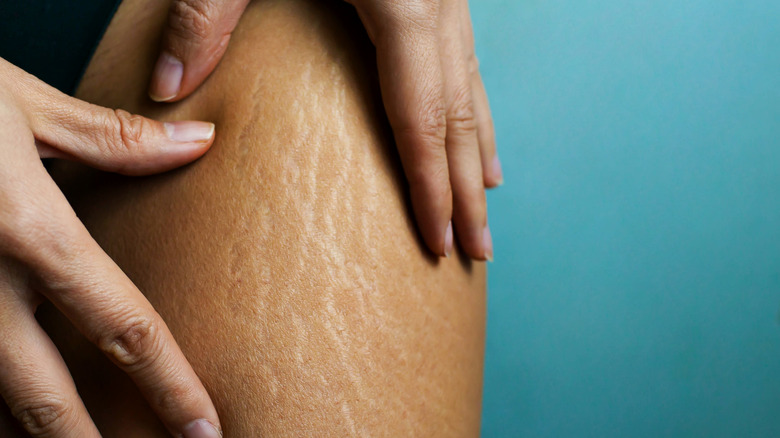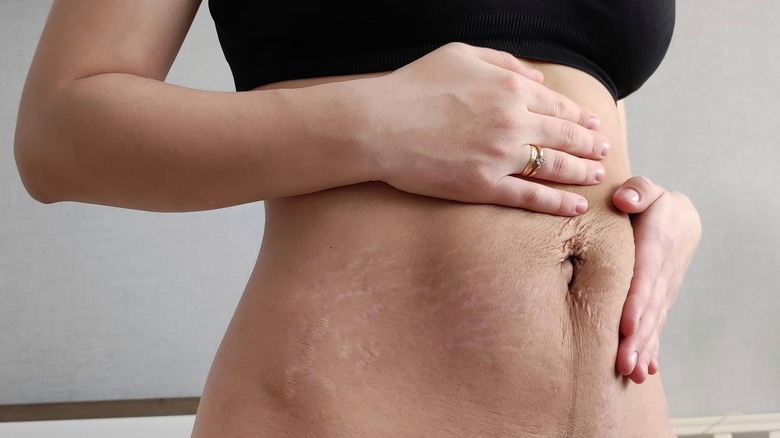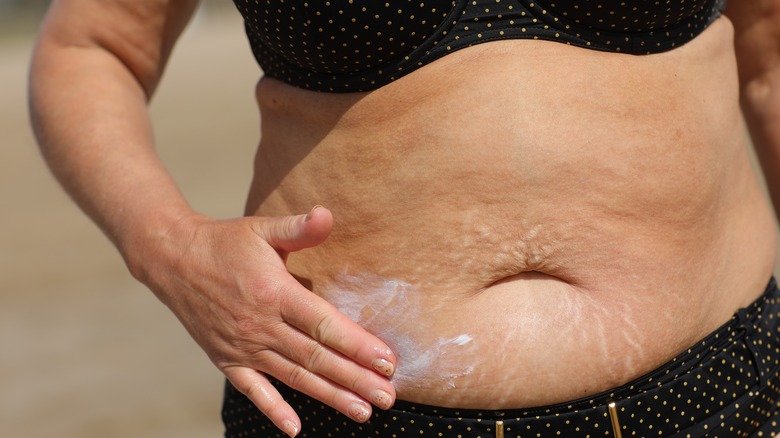Stretch Mark Fading And Weight Loss Do Not Go Hand In Hand. Here's Why
You've hit the gym consistently, incorporated more protein and veggies into your diet, and now you're several pounds slimmer. All is well and then you notice — or maybe you're already keenly aware — that your stretch marks remain. Or maybe you've just given birth and stretch marks line your stomach, creating a sight that's challenging for you to get used to. Or perhaps you've been working out and gained muscle and are confused by the new stretch marks making an appearance. Regardless, the thin, discolored lines etched upon your skin have a unique texture and boldly stand out. What do you do now?
Stretch marks are typically harmless — they can sometimes indicate an underlying medical issue, however, that's very rare. So, while they may not pose much of a physiological threat, they can be a cause of deep frustration for some. Understanding how and why they form may help with accepting them or with finding a method that may help fade them.
Why weight loss isn't necessarily the answer
Stretch marks form because the skin can't keep up with changes in weight. The skin's collagen and elastin protein rupture when you gain or lose a substantial amount of weight in a short amount of time, resulting in stretch marks.
Since stretch marks are often caused by growth and expansion — think of pregnancy, puberty, or situations where there's weight gain such as bulking up — some may think that weight loss could be the solution to getting rid of them. That's not the case. The truth about stretch marks is that they are difficult to get rid of. "Once [stretch marks] appear, they are permanent," New York-based dermatologist Whitney Bowe, M.D., told Beauty News NYC. "But there are many ways to help reduce their appearance." With that being said, stretch marks do sometimes fade and even disappear after weight loss, but there's no guarantee that they will.
When losing weight, it's best to go at a slow and steady pace. Not only is it more sustainable for you in the long term, but it also decreases your chances of developing stretch marks since you're giving your skin more time to adjust to the change in size.
Preventing and reducing stretch marks
Some suggest accepting stretch marks rather than fighting them. It's hard to prevent them — for example, you can't stop them if they form during puberty — and getting rid of them can be a hassle, so learning to accept the natural phenomenon can be a worthwhile solution. With that being said, you can be body neutral and/or body positive and still try to fade your stretch marks. If that's your desired outcome, creams and laser therapy are the traditional routes to go, but as with weight loss, there's no guarantee that they'll work.
Treating stretch marks early is your best chance at reducing their appearance. This is the time when topical products are likely to be most effective. Products containing Retin-A or vitamin A are good options to reach for. Some turn to laser therapy to address stretch marks. While it has the potential to be effective, it often yields mixed results and only reduces their appearance rather than erases them.
As far as preventing them, keeping your skin moisturized and applying products known to keep your skin firm are useful. Hyaluronic acid, olive oil, shea butter, coconut oil, and vitamin E are great ingredients to look for. You can also add foods containing zinc, protein, and, once again, vitamin E, to your diet.


